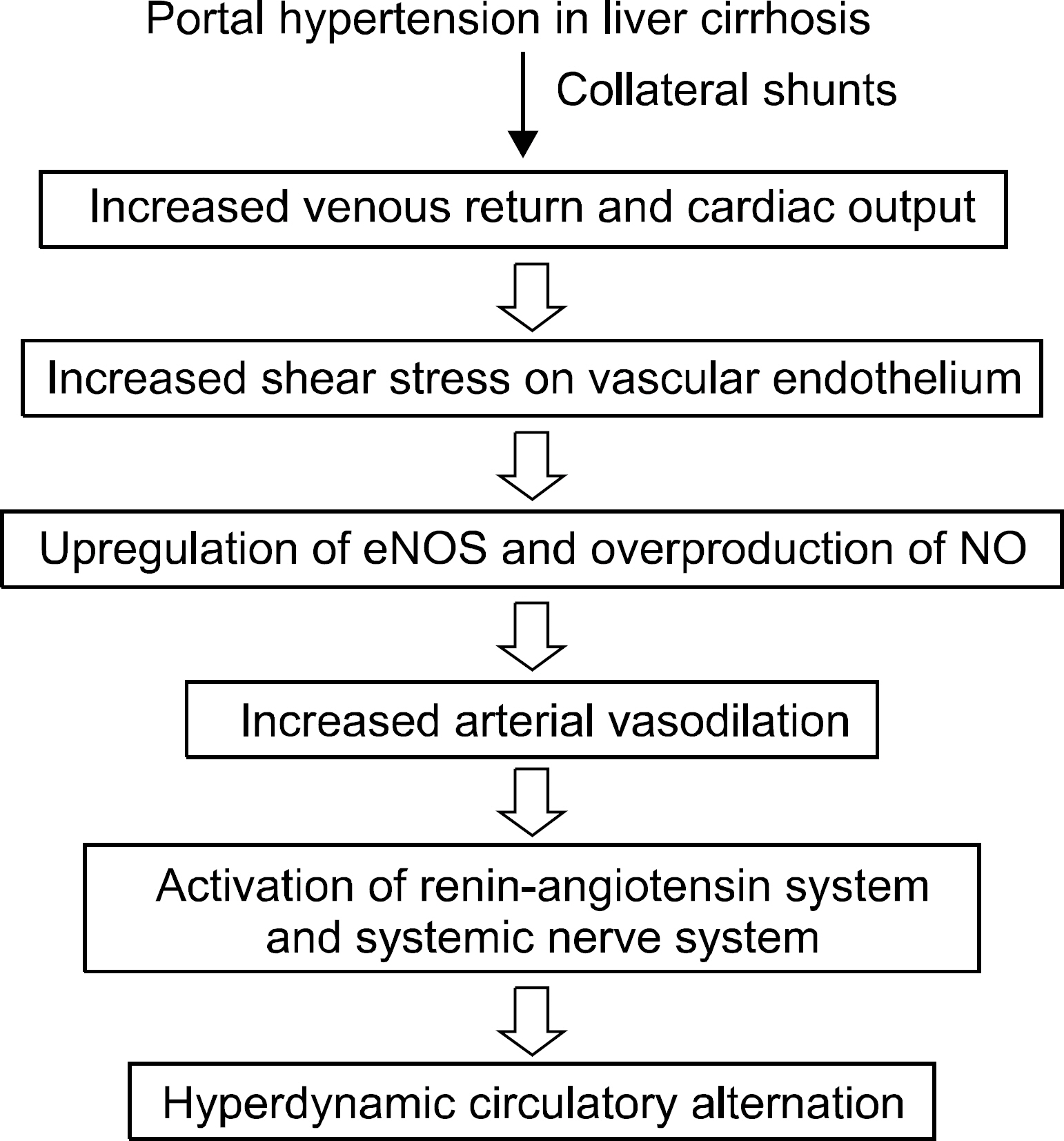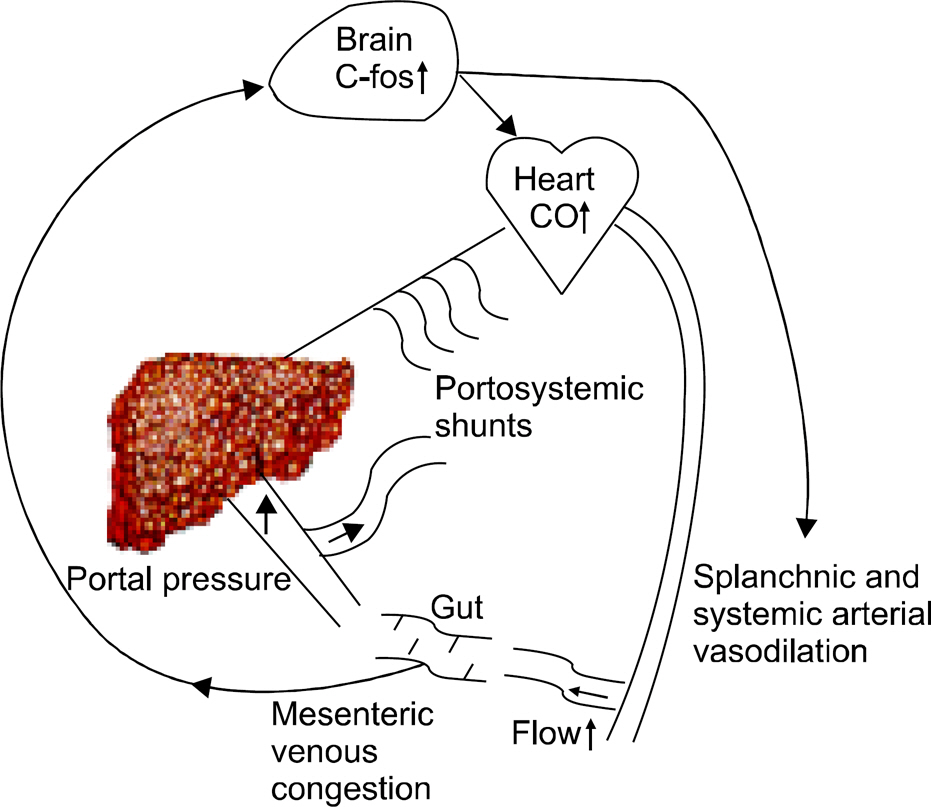Korean J Gastroenterol.
2009 Sep;54(3):143-148. 10.4166/kjg.2009.54.3.143.
Hyperdynamic Circulation in Patients with Liver Cirrhosis and Portal Hypertension
- Affiliations
-
- 1Department of Internal Medicine, Institute of Basic Medical Science, Yonsei University Wonju College of Medicine, Wonju, Korea. baiksk@yonsei.ac.kr
- KMID: 1775949
- DOI: http://doi.org/10.4166/kjg.2009.54.3.143
Abstract
- Hyperdynamic circulation in patients with liver cirrhosis is characterized by increased cardiac output and heart rate, and decreased systemic vascular resistance with low arterial blood pressure and currently focused on understanding the pathogenesis because of possibility of developing novel treatment modality. Basically, these hemodynamic alternations arise from portal hypertension. Portosystemic collaterals develop to counterbalance the increased intrahepatic vascular resistance to portal blood flow and induce an increase in venous return to heart. Increased shear stress in vascular endothelial cell related high blood flow by portosystemic shunting contributes to this up-regulation of eNOS resulting in NO overproduction. Additionally, bypassing through portosystemic collaterals and escaping degradation of over-produced circulating vasodilators in the diseased liver can promote the peripheral arterial vasodilation. Vasodilation of the systemic and splanchnic circulations lead to a reduced systemic vascular resistance, and increased cardiac output and splanchnic blood flow. Furthermore, neurohumoral vasoconstrictive systems including systemic nervous system, rennin angiotensin aldosterone system, and vasopressin are intensively activated secondary to vasodilation. However, hyperdynamic circulation would be more aggravated by the activated vasoconstrictive systems. With the progression of the cirrhotic process, hyperdynamic alternations can be more profound due to hyporesponsiveness to vasoconstrictors and increased shunt formation in conjunction with autonomic neuropathy. Eventually, splanchnic arterial vasodilation results in an increase portal venous inflow, maintaining the elevated portal venous pressure. Hyperdynamic circulation is intimately involved in portal hypertension with liver cirrhosis, therefore it is reasonable to have an interest in complete understanding of the pathogenensis of hyperdynamic circulation to develop novel treatment modality.
MeSH Terms
Figure
Reference
-
1. Kowalski HJ, Abelmann WH. The cardiac output at rest in Laennec's cirrhosis. J Clin Invest. 1953; 32:1025–1033.2. Im DW, Baik SK, Suh JI, et al. Hyperdynamic circulatory changes in liver cirrhosis: comparative evaluation by doppler ultrasonagraphy with normal subjects. J Korean Soc Med Ultrasound. 2001; 20:273–277.3. Baik SK, Choi YJ, Kwon SO, et al. Splanchnic and extra-splanchnic vascular hemodynamics in liver cirrhosis. Korean J Gastroenterol. 2000; 35:466–474.4. Baik SK, Park DH, Kim MY, et al. Captopril reduces portal pressure effectively in portal hypertensive patients with low portal venous velocity. J Gastroenterol. 2003; 38:1150–1154.
Article5. Baik SK, Jee MG, Jeong PH, et al. Relationship of hemodynamic indices and prognosis in patients with liver cirrhosis. Korean J Intern Med. 2004; 19:165–170.
Article6. Baik SK, Jeong PH, Ji SW, et al. Acute hemodynamic effects of octreotide and terlipressin in patients with cirrhosis: a randomized comparison. Am J Gastroenterol. 2005; 100:631–635.
Article7. Choi YJ, Baik SK, Park DH, et al. Comparison of Doppler ultrasonography and the hepatic venous pressure gradient in assessing portal hypertension in liver cirrhosis. J Gastroenterol Hepatol. 2003; 18:424–429.
Article8. Suk KT, Kim MY, Park DH, et al. Effect of propranolol on portal pressure and systemic hemodynamics in patients with liver cirrhosis and portal hypertension: a prospective study. Gut Liver. 2007; 1:159–164.
Article9. Baik SK, Kim JW, Kim HS, et al. Recent variceal bleeding: Doppler US hepatic vein waveform in assessment of severity of portal hypertension and vasoactive drug response. Radiology. 2006; 240:574–580.
Article10. Baik SK. Pharmacological therapy of portal hypertension-focused on Korean data. Korean J Gastroenterol. 2005; 45:381–386.11. Baik SK. Assessment and current treatment of portal hypertension. Korean J Hepatol. 2005; 11:211–217.12. Pateron D, Tazi KA, Sogni P, et al. Role of aortic nitric oxide synthase 3 (eNOS) in the systemic vasodilation of portal hypertension. Gastroenterology. 2000; 119:196–200.
Article13. Theodorakis NG, Wang YN, Skill NJ, et al. The role of nitric oxide synthase isoforms in extrahepatic portal hypertension: studies in gene-knockout mice. Gastroenterology. 2003; 124:1500–1508.
Article14. Batkai S, Jarai Z, Wagner JA, et al. Endocannabinoids acting at vascular CB1 receptors mediate the vasodilated state in advanced liver cirrhosis. Nat Med. 2001; 7:827–832.
Article15. Tarquini R, Masini E, La Villa G, et al. Increased plasma carbon monoxide in patients with viral cirrhosis and hyperdynamic circulation. Am J Gastroenterol. 2009; 104:891–897.
Article16. Liu H, Song D, Lee SS. Role of heme oxygenase-carbon monoxide pathway in pathogenesis of cirrhotic cardiomyopathy in the rat. Am J Physiol Gastrointest Liver Physiol. 2001; 280:G68–74.
Article17. Guevara M, Gines P, Jimenez W, et al. Increased adrenome-dullin levels in cirrhosis: relationship with hemodynamic abnormalities and vasoconstrictor systems. Gastroenterology. 1998; 114:336–343.
Article18. Ackermann D, Vogt B, Escher G, et al. Inhibition of 11 beta-hydroxysteroid dehydrogenase by bile acids in rats with cirrhosis. Hepatology. 1999; 30:623–629.19. Lin HC, Yang MC, Hou MC, et al. Hyperglucagonaemia in cirrhotic patients and its relationship to the severity of cirrhosis and haemodynamic values. J Gastroenterol Hepatol. 1996; 11:422–428.
Article20. Moller S, Bendtsen F, Schifter S, Henriksen JH. Relation of calcitonin gene-related peptide to systemic vasodilation and central hypovolemia in cirrhosis. Scand J Gastroenterol. 1996; 31:928–933.21. Lee FY, Lin HC, Tsai YT, et al. Plasma substance P levels in patients with liver cirrhosis: relationship to systemic and portal hemodynamics. Am J Gastroenterol. 1997; 92:2080–2084.22. Moreau R, Lebrec D. Endogenous factors involved in the control of arterial tone in cirrhosis. J Hepatol. 1995; 22:370–376.
Article23. Sieber CC, Sumanovski LT, Moll-Kaufmann C, Stalder GA. Hyposensitivity to nerve stimulation in portal hypertensive rats: role of nitric oxide. Eur J Clin Invest. 1997; 27:902–907.
Article24. Braillon A, Cales P, Valla D, Gaudy D, Geoffroy P, Lebrec D. Influence of the degree of liver failure on systemic and splanchnic haemodynamics and on response to propranolol in patients with cirrhosis. Gut. 1986; 27:1204–1219.
Article25. Song D, Liu H, Sharkey KA, Lee SS. Hyperdynamic circulation in portal-hypertensive rats is dependent on central c-fos gene expression. Hepatology. 2002; 35:159–166.
Article26. Song D, Sharkey KA, Breitman DR, Zhang Y, Lee SS. Disordered central cardiovascular regulation in portal hypertensive and cirrhotic rats. Am J Physiol Gastrointest Liver Physiol. 2001; 280:G420–G430.
Article27. Baik SK, Fouad TR, Lee SS. Cirrhotic cardiomyopathy. Orphanet J Rare Dis. 2007; 27:15.
Article28. Dumcke CW, Moller S. Autonomic dysfunction in cirrhosis and portal hypertension. Scand J Clin Lab Invest. 2008; 68:437–447.29. Youn MO, Kang SJ, Jun IG, et al. Assessment of cardiovascular autonomic function in patients with liver cirrhosis using heart rate variability blood pressure variability and baroreflex sensitivity. Korean J Anesthesiol. 2006; 50:655–662.
Article30. Campbell PJ, Leung WM, Logan AG, Debowski TE, Blendis LM, Skorecki KL. Hyperresponsiveness to water immersion in sodium retaining cirrhotics: the role of atrial natriuretic factor. Clin Invest Med. 1988; 11:392–395.31. Cereda JM, Roulot D, Braillon A, Moreau R, Koshy A, Lebrec D. Reduction of portal pressure by acute administration of furosemide in patients with alcoholic cirrhosis. J Hepatol. 1989; 9:246–251.
Article32. Ortega R, Gines P, Uriz J, et al. Terlipressin therapy with and without albumin for patients with hepatorenal syndrome: results of a prospective, nonrandomized study. Hepatology. 2002; 36:941–948.
Article33. Reynaert H, Geerts A. Pharmacological rationale for the use of somatostatin and analogues in portal hypertension. Aliment Pharmacol Ther. 2003; 18:375–386.
Article34. La Villa G, Barletta G, Pantaleo P, et al. Hemodynamic, renal, and endocrine effects of acute inhibition of nitric oxide synthase in compensated cirrhosis. Hepatology. 2001; 34:19–27.
Article35. Fiorucci S, Antonelli E, Brancaleone V, et al. NCX-1000, a nitric oxide-releasing derivative of ursodeoxycholic acid, ameliorates portal hypertension and lowers norepinephrine-induced intrahepatic resistance in the isolated and perfused rat liver. J Hepatol. 2003; 39:932–939.
Article36. Piomelli D, Giuffrida A, Calignano A, Rodriguez de Fonseca F. The endocannabinoid system as a target for therapeutic drugs. Trends Pharmacol Sci. 2000; 21:218–224.
Article37. Barriere E, Tazi KA, Pessione F, et al. Role of small-conductance Ca2+-dependent K+ channels in in vitro nitric oxide-mediated aortic hyporeactivity to alpha-adrenergic vasoconstriction in rats with cirrhosis. J Hepatol. 2001; 35:350–357.38. Mejias M, Garcia-Pras E, Tiani C, Miquel R, Bosch J, Fernandez M. Beneficial effects of sorafenib on splanchnic, intrahepatic, and portocollateral circulations in portal hypertensive and cirrhotic rats. Hepatology. 2009; 49:1245–1256.
Article
- Full Text Links
- Actions
-
Cited
- CITED
-
- Close
- Share
- Similar articles
-
- Update on the treatment of portal hypertension
- Effects of portal hyperperfusion on partial liver grafts in the presence of hyperdynamic splanchnic circulation: hepatic regeneration versus portal hyperperfusion injury
- Hemodynamic alterations in cirrhosis and portal hypertension
- Pathophysiology and diagnosis of portal hypertension
- Recent Advances in the Pathogenesis and Clinical Evaluation of Portal Hypertension in Chronic Liver Disease



